Today
is more or less this.
After
the
town at the centre of things, we come to an in-betweeny space where not
much seems to happen. There are fields. Ducks. Overhead cables. It’s quiet back
here.
 |
| Geese on the banks of Rivermead Park, West Reading. |
 |
| The river near Pangbourne. Railways, pylons and other infrastructure crisscross this backstage space for Reading and its surrounding settlements. |
The
central Thames thus far has been a procession of castles and palaces, mansions
and monasteries, elite schools and sports facilities and sprawling land-grabs by the monied obscene. The Privilege Forts of
the English south line up along their valley of imagination: a furnace-belt of
willows and glistening water, insulated from its country’s sordid realities by
its fortress-walls of inherited wealth as it roars in the manufacture of narratives
of high-caste white Englishness.
As
we have seen, the hammering from these foundries is loud and relentless. Theirs
are the stories they want the whole nation to hear.
And
then, on the far side of Reading – they fade.
The
upper-middle Thames dispenses with the battlements, searchlights and
megaphones. In their place unfurl rolling lowlands, spread with farms and
dotted with small villages through which the river comes gliding. Some of these
settlements are historic, ancient even, while their surroundings continue to
supply the green-and-pleasant backdrop to the English national reverie. Yet now
the volume is dialled right down. These settlements merely speak their stories,
rather than shout them – except, of course, for one of the loftiest Privilege
Forts of all, which waits at the end of this sequence in a certain city known
as Oxford.
But
there is a more important transition beneath that. Literally.
Oxford
sits in a basin whose clay is geologically distinct from that of the
lower valley. To push north on this island is as to delve deeper in time. Where
London’s surface clay is young – that is, Cenozoic, about 50 million years old
– Oxford’s goes back some 100 million years further to the Late Jurassic period.
And through the space and time in between runs an outer arm of the great network
of Late Cretaceous chalk deposits (from c.65-95 million years ago) which
stretch across southern England and northwest Europe – and whose separation, of
course, is wholly imaginary.
 |
| One segment of that arm is well familiar by now. The chalk ridge of the Chiltern Hills has overlooked the north bank all the way from Marlow. |
This
chalk has dramatically reshaped both the landscape itself and its imagery in
English culture, and among those effects have been significant changes to the river’s
course. There was a time the Thames pushed straight east into the North Sea. But finding its way blocked during the glaciations of the most recent ice age,
it cut a gap through the relatively permeable chalk and has since skewed down
through the London Basin instead.
It
is through this gap that we now pursue it, with a better look at this realest
of deep-history in the next section. For today the goal is the foot of that gap,
where the river emerges between the villages of Pangbourne and Whitchurch.
 |
| Thames Water HQ, with its sinister spiral stairs in transparent tubes, hulks over the river at Reading Bridge where today’s progress begins. |
Start:
Reading Bridge (nearest station: Reading)
End:
Whitchurch Bridge (nearest station: Pangbourne)
Length:
11.2km/7 miles
Location:
Oxfordshire – South Oxfordshire; Berkshire – Borough of Reading, West Berkshire
District
Topics:
West Reading suburbs, Purley, Pangbourne – shifting satellite
settlements on the edge-of-centre
Reading outskirts
Our
main task today is to escape Reading. The town has an imprint on its surrounding
land to match its pivotal
historical position, and so most of this walk is spent shaking loose of the suburbs and infrastructure laid down in reference to it.
Between
Reading’s principal bridges is an islet, seen here at left. Where it got its
name of Fry’s Island is not clear, but it comes with a political anecdote
that gives it its other name of De Montfort Island. It concerns
a public duel said to have taken place here in 1163 between two nobles from the
court of King Henry II – the first king of the Plantagenet dynasty from Anjou,
which is now in France but whose state, on his succession, also inherited
England. That arrangement was as much a mess as it sounds and resulted from the
violent upheaval that followed the death of his father’s uncle, the first
Henry, whose Reading
Abbey project was at last coming to fruition.
The
combat itself arose over an accusation of dishonourable conduct in battle, and
its outcome was that the accusing noble, Robert de Montfort, grievously wounded
the man he accused, the king’s standard-bearer Henry of Essex. Such a duel having
the equivalence of a judicial trial in that period, Henry of Essex was judged
guilty and stripped of his lands and titles. But the king had him brought to
Reading Abbey, where he was healed by the monks and supposedly joined them
afterwards.
Perhaps
that’s this incident’s broader significance. The duel took place here at all
because Henry II happened to be holding court at Reading Abbey. The monastery’s
prominence in this little tale attests that despite the disastrous ructions
that followed its founder’s death, despite even his Norman dynasty’s transition
to an Angevin one, his grand project at the crossroads had endured and was
ready to stand as a stable base of power.
 |
| Fry’s Island also hosts this boatyard. Coincidentally or otherwise, the lion seems to have been the primary motif in the heraldry of the De Montfort family. |
Approaching
Reading’s main crossing of Caversham Bridge, it becomes apparent that this
settlement’s role as a centre ground also extends to the river’s bird life.
 |
| To live along here must come with the expectation that they’ll eat bits off your house. |
 |
| Apartments overlook the river between Reading’s bridges. |
 |
| In this yard a group of elderly residents was engaged in some socially-distanced morning exercise routine. These enormous swans stood in the middle, looking faintly perplexed. |
 |
| It was evident from posters that the local people are actively engaged in helping look after the cygnets here. |
Caversham
Bridge has long been Reading’s principal crossing. It originated not long
after the aforementioned duel, probably under the auspices of the Abbey to
improve its connection to Oxford. A sizeable manorial community seems to have
already existed on the north bank.
 |
| Caversham Bridge, with the obligatory war memorial at right. |
 |
| In spite of its heritage, the current bridge is a granite replacement from 1926. See the previous section on how it was badly damaged in the civil war and languished for many generations. |
And
on the upstream side...
Have you ever seen so many swans in one place? A glance through local newspaper commentary suggests that contrary to
popular warnings about handing out food to water birds, Reading’s large swan
population has in fact grown reliant on humans feeding them to the point that
they have started to face starvation risks because of people withholding food
in reaction to said warnings. Evidently this is a relationship they are still working
out.
 |
| The swans here seem remarkably organised, even keeping to a single set of lanes while conceding the outer lanes to ducks. |
 |
| From here Rivermead Park accompanies the river all the way out of Reading proper. |
There
now follows a long fringe of parks, fields and farms, which together make up a
wedge of open land between the river and the Great Western Railway. How has
this slice of rurality survived the otherwise unstoppable appetite of suburban
sprawl? Does it hold extra-special significance for the local people, perhaps
in its role as the venue for the annual Reading Festival? Or has its
vulnerability to flooding kept the property speculators off it?
 |
| Like this. |
 |
| And this. |
 |
| And here we have a Middle-Finger Tree, which has no doubt grown up to support those on the south side against such shows of ostentation. The ring of pennants must indicate their alliance. |
As
with the stretch downstream of Reading, there is an after-the-apocalypse
solemnity in the air here. Even under this overcast sky the park is bright,
green and spacious; surely it should be full of people strolling, playing ball
games, napping, feeding the ducks or sitting around reading newspapers. But
aside from the odd passer-by it is close to deserted.
If
we might put this down to the isolating effects of COVID-19, it is worth
recalling that going for walks in spaces like this has been about the only safe
outdoor pastime available to people in the English urban centres. One can only
suspect that the true malady at issue here is the deeper one: the shipwrecked
modernity of abusive power structures and a toxic work culture that forces the
present-day English commoner to struggle all day just to put food on the table,
and to regard rest and recreation as unaffordable luxuries rather than a health
need and a natural human entitlement.
 |
| As the park stretches on, human activity on both banks steadily recedes. |
 |
| Soon the tarmac promenade returns to dirt towpath, and the managed parkland gives way to open fields. |
After
approximately two kilometres in this vein, a riverbend brings the Great Western
Railway right up beside the river, whereafter the two proceed in parallel for a
time. This track, the main connection between London and Bristol, runs some way
north up the river valley from here. This seems to have been a deliberate
decision by their engineer-hero Isambard Kingdom Brunel, who rather than run
his signature railway straight west, had it arc north beyond Reading to offer a
connection to Oxford along the way.
 |
| This large boatyard is one of the only human installations on the banks out here. |
 |
| The thistles here have grown plentifully this summer, no doubt as a further warning to the natives that their behaviour is provoking Scottish independence. |
 |
| And here the river and rails draw together. Across the railway is the suburb of Tilehurst, but the walled rail embankment cuts it off from the riverside. |
Tilehurst
is a large suburb west of Reading on the Oxford road. It has its own railway
station here which cannot be reached from the towpath. Originally a hamlet
controlled by Reading Abbey, it was passed down a chain of manorial inheritance
after Henry VIII smashed the monastery. The railway was put through it in the
late nineteenth century, after which it was absorbed into Reading and
transformed into a residential suburb.
The
recentness of that absorption is notable. Suburbs do not simply exist by nature
but are rather a distinct historical phenomenon. Most English suburbs, like
Tilehurst, are creatures of nineteenth- and twentieth-century industrialisation,
because it was only with the spread of train and motor car infrastructure, and
the movements they enabled – the mass commute to urban factories and the middle-class escape from them – that suburbs
came to make conceptual sense.
Tilehurst’s
northern part retains the name of the original neighbouring manor of Kentwood.
Hence the name given to this isolated stretch of river, the Kentwood Deeps.
 |
| Trains go on one side, boats on the other, while those on foot tread this narrow thread through the middle. |
 |
| Evidence of Reading’s secret socialist sympathies can be found painted on the wall. |
 |
| And here must be the switch that turns the Great Western Railway on and off. |
Despite
the constrained character of the path here, it still offers hints as to these
people’s ways of life.
 |
| The river looks good when the English property culture isn’t grasping at it. |
 |
| Another questionable arrangement. What does this tell us about the English of the middle Thames valley? |
Eventually
the river bends once more, opening up another chunk of agrarian land. But at
this point, yet again, wayfarers are forced across a footbridge over the
railway so as not to inconvenience the property-dreams of those who dared think
to privatise the riverside. Like others we have passed on the way,
these landlords fiercely refused to allow the Thames Navigation Commission to install the
towpath across their land, which necessitates us, more than two centuries later, to take an inland detour through
the settlement of Purley.
 |
| ...but alas, this is England under market fundamentalism, and so it turns out the venerable Roebuck was closed in 2010 and converted to private apartments. |
Purley
Purley-on-Thames
exists in flux. After some thousand years as an agricultural area split between
three manors – Purley Magna in the east, Purley Parva in the
northwest, and Purley La Hyde in the southwest (note the continental
inheritance in these names), the processes of so-called modernity have dragged
it messily in different directions.
 |
| Wooded enough to afford the river-seeker a brief escape from the Oxford Road... |
 |
| ...though one should be careful not to disturb any beetles one happens to find fornicating in the middle of the path. |
The
manor grounds of Purley Magna – this eastern part – were thoroughly transformed
by the railway and the motorisation of the Oxford Road, and have since been
absorbed into the Reading conurbation as its outermost riverside suburb.
Perhaps on account of its titled inheritance it appears to be another of Reading’s
chunks of relative wealth – hence the property-grab along the riverbend – but
makes up for this privilege with its susceptibility to devastating floods.
Purley
Parva and Purley La Hyde have likewise seen many of their manorial estates
redone into apartments, but their expanses of farm fields, north and south of
the rails respectively, remain largely intact. These account for the belt of
green between the Reading sprawl to the east and the valley of the River Pang
to the west. The best-known occupant of La Hyde’s manor house appears to have
been a certain Warren Hastings, the disgraced Governor-General of Bengal for
the East India Company, during his sensational impeachment trial in the 1790s.
 |
| The gates of the manor house of Purley Magna, now unaffordable flats. Its private park still occupies the centre of the suburb. |
 |
| Along the suburb’s western rim, the old access road to Mapledurham Lock offers a route back to the river. |
 |
| Whoever designed this poster is exactly right. |
 |
| I have been hesitant to offer food and drink recommendations on this journey because so many of the traditional pubs and cafés have been taken over by big corporations with no connection to the local communities. Purley however conceals a refreshing surprise. Close to the river, hidden behind the houses on Wintringham Way, the Mad Duck Café is a unique and characterful rest stop run by local families which offers excellent lunches and cakes for very generous prices. Seating is currently outdoors only due to COVID-19. |
When
we rejoin the river, it is to face another large piece of inherited affluence. Like
Purley the north-bank Mapledurham estate goes back at least to the 1086
Domesday survey, but its country house was built in the Elizabethan 1580s. Blasted,
seized and sacked by the Parliamentary army during the civil war, it was later
recovered by the gentry and has since passed down a long chain of succession to
its present holders, the Eyston family.
Unusually,
these dwellers have sought to leverage Mapledurham’s picturesque heritage by opening up the house and grounds for
public tours, while diversifying its offerings with sustainable farming and
leisure initiatives. Its atmospheric setting has also drawn film crews, leading
it to feature in several decades’ worth of movies and TV series.
Regrettably
an assessment of these efforts in the context of the broader English problems
of land and class is beyond this expedition. Mapledurham is unreachable from
this side of the river, and the house, grounds, and tours have all closed this
year on account of COVID-19.
 |
| From the south side Mapledurham House can only be glimpsed through the summer foliage. |
 |
| The banks facing Mapledurham are pleasant meadowland with sandy riverside beaches, ideal for fluffy encounters like these. |
 |
| Those wishing not to be eaten by plants might be advised against sitting here. |
All
that remains for today is a brisk trek across the meadows of what was
presumably the territory of Purley Parva. This is still predominantly farmland,
centred around what was once the manor’s tiny village of Westbury, from where some
curious present-day inhabitants have come down to investigate passers-by.
 |
| The way beyond Mapledurham Lock. The low escarpment of the Chiltern Hills soars close on the far side, anticipating its landing just a little further upstream. |
 |
| And what is that concentration of biomass over there? |
 |
| Yes. |
The open grass of this final stretch offers some of today’s best scenery, with good views of the declining Chiltern slopes across the way.
 |
| Unlike the parkland close to Reading the riverbanks here seem largely left to their own devices. |
 |
| Then appears the landscaped vista of Hardwick House, another Toad Hall whose estate dominates the north bank here. |
Much
like neighbouring Mapledurham, Hardwick House anchors an ancient
Saxon-era estate whose house got upgraded into a big Tudor mansion in the late
sixteenth century. Its story mirrors its neighbour’s in the close
association of its resident Lybbe family with the ruling monarchy, which got it similarly ransacked by the Parliamentary army during the civil
war. The Lybbes got it back but eventually struggled financially and in 1909
they sold the estate to the Rose family, which lives there to this day. Like
the Eystons at Mapledurham they have attempted to branch out their land use, in this case into forestry and organic
farming.
 |
| A number of interesting rural concerns dot the orbit of the Hardwick estate. There’s an alpaca farm over there somewhere. |
The
approach to Pangbourne leads through its own meadow, a partial
nature reserve which the village manages alongside the National Trust.
 |
| As helpfully signposted. |
 |
| Natives fish on the banks of Pangbourne Meadow. |
Pangbourne
Pangbourne,
along with its opposing village of Whitchurch, is a communications
junction: a minor outlying node of Reading where the
roads converge at a convenient river crossing at the mouth of the Pang.
The Pang is a lush chalk stream, and the bourne to which Pangbourne’s
name refers.
Accordingly
the settlement goes back a very long way. It was on the old road between the
Roman outposts of Silchester (south) and Dorchester (north); the
eighteenth-century railway-builders discovered a Roman cemetery nearby. Its
present name emerged after Anglo-Saxon immigration and is thought to refer to a
local chief called Pæga. It then occurs in writing as Peningaburnan
in 844 in a land grant to a certain Bertwulf, king of the central Saxon kingdom
of Mercia which the Vikings overwhelmed a few decades later.
 |
| The village sign depicts this Bertwulf, as well as a Viking longship. The book in between is The Wind in the Willows, commemorating Pangbourne’s connection to Kenneth Grahame. |
 |
| Pangbourne’s high street. It’s a small village, with its centre to the east of the Pang and railway station to the west. |
Pangbourne’s
later story unfolded in the dominant shadow of Reading
Abbey, to which it was given by Henry I at the latter’s foundation. Its
manor house (inland to the southwest) was supposedly a popular summer getaway
for the monastery’s abbots. More Englishly it was in its underground tunnels
that the last of those abbots, Hugh Faringdon, was dragged from hiding to be
butchered alive at the Abbey’s destruction in 1539. The violence of the civil
wars also left their mark: the road upriver rises up Shooters’ Hill, apparently
so named for its Royalist artillery fortifications whose cannonballs were dug
up when they built the railway.
That’s
about it really. Pangbourne seems less a place where big things happen than a
place people pass through on their way to those places where they do. Fitting
perhaps for this margin of transitions, this quiet backstage connection-space
between the Reading and Oxford spheres of influence. You could say it has
transformed a great deal, and is still transforming. Or you could say it has in
fact changed very little, with the river sliding through as it has for as long
as there have been people here to witness it.
But
it wasn’t always here. And if this country’s failure at pandemic
governance doesn’t cause the latest wave of COVID-19 (that is, the
Modi/BJP variant) to go completely out of control in the next few days, the
next stage of this journey will cross the chalk to the time the river cut
through this way in the first place.


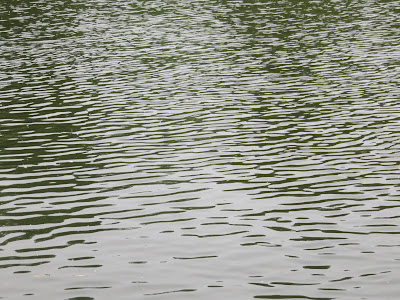














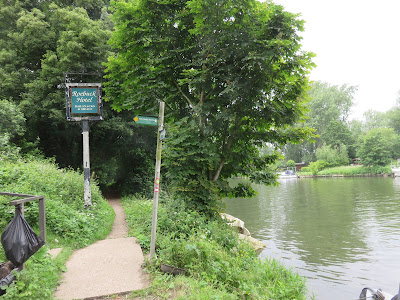


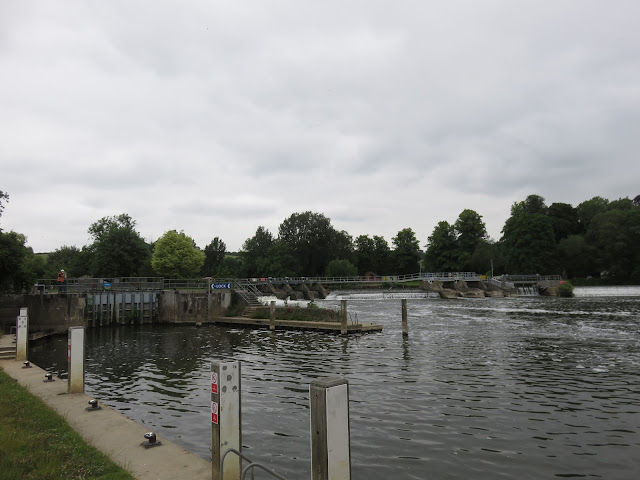


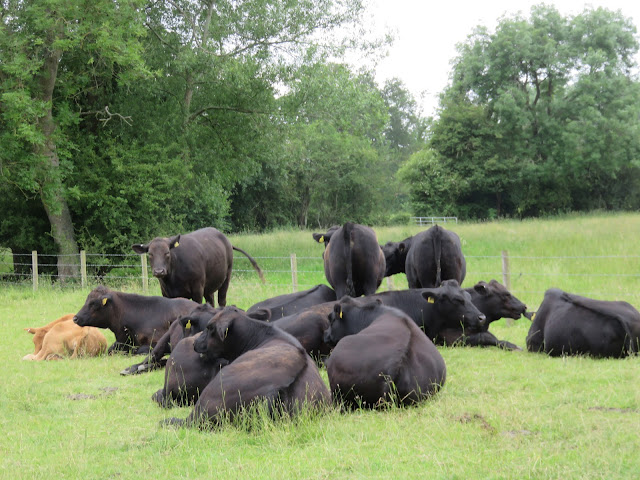
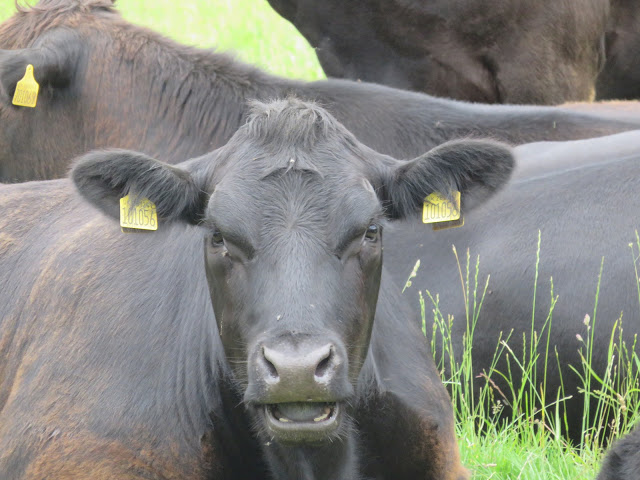







No comments:
Post a Comment